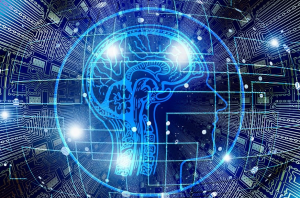Artificial intelligence
what is artificial intelligence?
Artificial intelligence is a wing of computer science involved in building smart machines that are able to accomplish tasks that typically need human intelligence. AI is an interdisciplinary science with multiple approaches, but advancements in machine learning and deep learning are creating a model change in practically every area of the tech industry.
How Does Artificial Intelligence Work?
Artificial intelligence is focused on making machines do the following tasks.
- Thinking humanly
- Thinking rationally
- Acting humanly
- Acting rationally
The first two “Thinking humanly” and “Thinking rationally” concern thought processes and reasoning, while the others deal with the behaviour. The AI scientists, Norvig and Russell, focus mainly on rational agents that act to achieve the best outcome.
How is Artificial Intelligence Used?
Artificial intelligence commonly falls under two broad classes:
- Narrow AI
- Artificial General Intelligence (AGI)
Narrow Artificial Intelligence
This sort of AI works within a limited playground. Weak AI is a mirroring of human knowledge. Narrow AI is often centred on doing a single task remarkably well. While these robots may appear intelligent, they are working under far more limitations and conditions than even the most fundamental human intelligence.
A few examples of Narrow AI cover:
- Search engine like Google
- Image recognition and detection
- Google Assistant, Siri, Alexa and other personal assistants
- Self-driving cars
Narrow artificial intelligence includes
- Machine learning
- Deep learning
Machine learning
Machine learning supplies machine information and uses statistical methods to ease it “learn” how to become progressively more beneficial at a task, without having been explicitly programmed for that job, dropping the need for millions of lines of compiled code. Machine learning is subdivided into
- supervised learning (labelled data is used)
- unsupervised learning (un labeled information is used).
Supervised learning
Supervised learning is a way of designing AI, where the program is given labelled input information and the expected outcomes. The AI method is individually guided for what to watch for; thus, the model is practised until it can identify the underlying designs and associations, allowing it to produce better outcomes when impersonated with never-before-seen data.
Unsupervised learning
Unsupervised learning is also a way of designing AI, in which the program is given un-labelled input data. The model is allowed to group similar data. Unsupervised learning is the education of machines utilising data that is not classified either named and letting the algorithm to work on that data without supervision.
Deep learning
Deep learning is a subtype of machine learning that runs inputs in neural network architecture. The neural networks are designed on how the human mind works. The neural networks include many hidden layers in which the data is processed, enabling the machine to go “deep” in its training, making associations and weighting input for the most reliable outcomes.
Artificial General Intelligence
Artificial General Intelligence(AGI) is the type of AI we usually see in the films. AGI is a tool with general intelligence and, much like a human creature, it can use that intelligence to resolve any enigma.
Importance of Artificial Intelligence
AI automates repeated training and development by information. AI appends intelligence to existing products. AI changes by continuous training algorithms to allow the data to do the programming. AI gains structure and uniformity in data so that the algorithm gets an experience: The algorithm grows a classifier or a predictor. So, just as the algorithm can show itself how to play chess, it can manifest itself as a stock to promote next to an online customer.
Applications of Artificial Intelligence
Marketing: Marketing is a way to candy coat your goods to bring more clients. We, people, are pretty high at candy coating, but what if an algorithm or a bot is created only to market a trademark or a company?
When we seek an item on any e-commerce shop, we get all likely results linked to the subject. It’s like these search engines know our thoughts! In some seconds, we see a list of all related things. An illustration of Artificial intelligence can be seen while searching for the right film on Netflix.
Banking: AI in banking is increasing quicker than ever. Many banks are already using AI-based systems to give client support, detect irregularities and credit card scams. An illustration of Artificial intelligence is the HDFC Bank.
HDFC Bank has produced an AI-based chatbot called EVA(Electronic Virtual Assistant).
After its launch, Eva has directed over 3 million customer questions, communicated with over half a million different users, and held over a million consultations. Eva can accumulate information from thousands of sources and provide straightforward solutions in fewer than 0.4 instants.
Agriculture: Problems such as environmental change, population growth, and meals security matters have forced the manufacturers into attempting more innovative methods to grow crop yield.
Companies are using industrialisation and robotics to help producers find more effective means to protect their crops from weeds.
Blue River Technology has produced a robot called See & Spray, which utilises computer vision technologies like object recognition to control and accurately sprinkle weedicide on cotton plants. Exactness spraying can assist in stop herbicide resistance.
The image recognition app recognises likely deficiencies by images taken by the user’s smartphone camera. Users are then provided with soil recovery methods, suggestions, and other potential resolutions. The organisation claims that its software can perform pattern detection with an expected efficiency of up to 95%.
Autonomous Vehicles
The AI system gathers data from the vehicles radar, cameras, GPS, and cloud services to generate control signs that move the vehicle. Advanced Deep Learning algorithms can precisely foretell what things in the vehicle’s environment are expected to do. AI implements computer vision, image detection and deep learning to produce cars that can automatically identify things and ride around without human interference.
